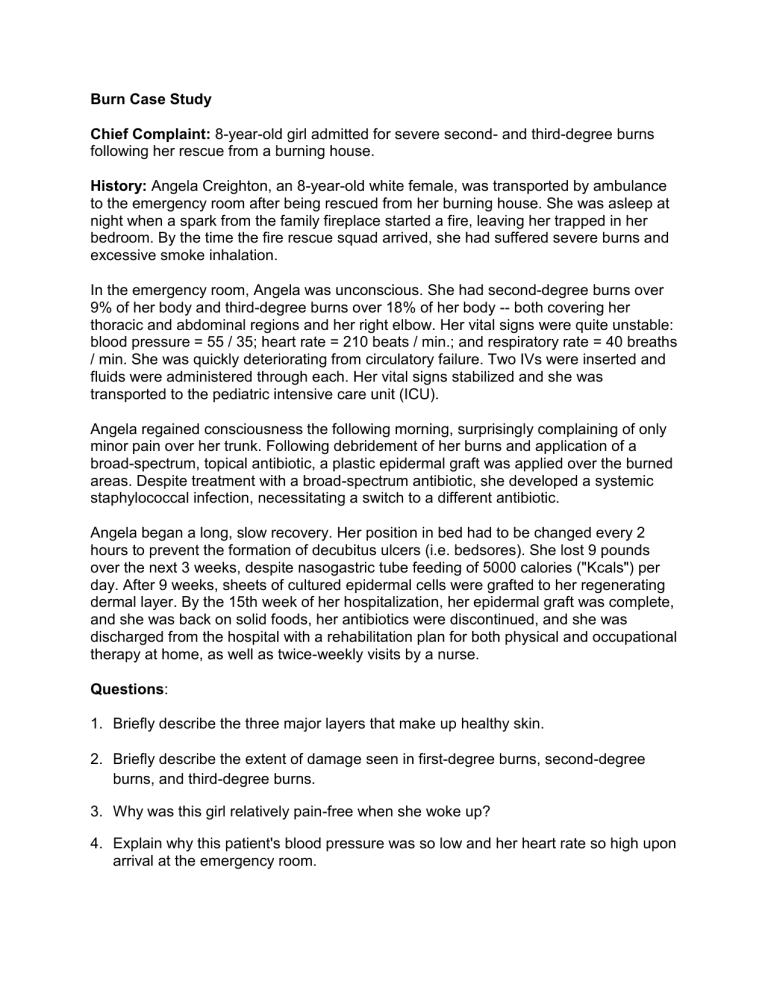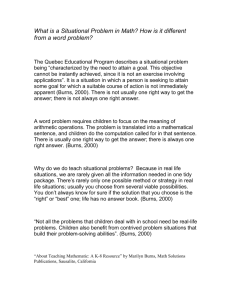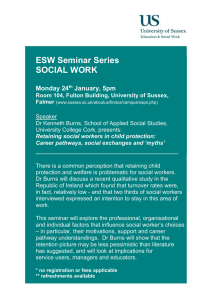
Burn Case Study Chief Complaint: 8-year-old girl admitted for severe second- and third-degree burns following her rescue from a burning house. History: Angela Creighton, an 8-year-old white female, was transported by ambulance to the emergency room after being rescued from her burning house. She was asleep at night when a spark from the family fireplace started a fire, leaving her trapped in her bedroom. By the time the fire rescue squad arrived, she had suffered severe burns and excessive smoke inhalation. In the emergency room, Angela was unconscious. She had second-degree burns over 9% of her body and third-degree burns over 18% of her body -- both covering her thoracic and abdominal regions and her right elbow. Her vital signs were quite unstable: blood pressure = 55 / 35; heart rate = 210 beats / min.; and respiratory rate = 40 breaths / min. She was quickly deteriorating from circulatory failure. Two IVs were inserted and fluids were administered through each. Her vital signs stabilized and she was transported to the pediatric intensive care unit (ICU). Angela regained consciousness the following morning, surprisingly complaining of only minor pain over her trunk. Following debridement of her burns and application of a broad-spectrum, topical antibiotic, a plastic epidermal graft was applied over the burned areas. Despite treatment with a broad-spectrum antibiotic, she developed a systemic staphylococcal infection, necessitating a switch to a different antibiotic. Angela began a long, slow recovery. Her position in bed had to be changed every 2 hours to prevent the formation of decubitus ulcers (i.e. bedsores). She lost 9 pounds over the next 3 weeks, despite nasogastric tube feeding of 5000 calories ("Kcals") per day. After 9 weeks, sheets of cultured epidermal cells were grafted to her regenerating dermal layer. By the 15th week of her hospitalization, her epidermal graft was complete, and she was back on solid foods, her antibiotics were discontinued, and she was discharged from the hospital with a rehabilitation plan for both physical and occupational therapy at home, as well as twice-weekly visits by a nurse. Questions: 1. Briefly describe the three major layers that make up healthy skin. 2. Briefly describe the extent of damage seen in first-degree burns, second-degree burns, and third-degree burns. 3. Why was this girl relatively pain-free when she woke up? 4. Explain why this patient's blood pressure was so low and her heart rate so high upon arrival at the emergency room. 5. Why was it important to immediately administer intravenous fluids to this girl? 6. What is a "broad-spectrum" antibiotic, and why did she need it? Is healthy skin normally colonized by bacteria? 7. Why was skin-grafting necessary in this patient? (Why not just let the skin heal on its own?) 8. Describe the series of events that occur in skin which is healing with the help of a skin-graft. 9. Why are bedridden patients at risk for developing decubitus ulcers? Where on the body do such ulcers most commonly occur? 10. Why did the patient lose so much weight despite being on a very high-calorie diet? 11. What long-term problems may the patient have as a result of extensive scar tissue formation over her trunk and her right elbow?


